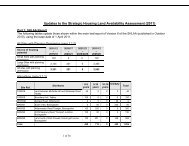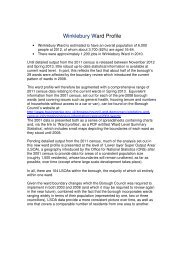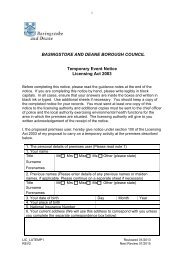Body Piercing Advice and Safe Practice - Charnwood Borough ...
Body Piercing Advice and Safe Practice - Charnwood Borough ...
Body Piercing Advice and Safe Practice - Charnwood Borough ...
You also want an ePaper? Increase the reach of your titles
YUMPU automatically turns print PDFs into web optimized ePapers that Google loves.
What do I need to do to ensure safe<br />
treatment at my premises? (e)<br />
I’m bombarded with information on cleaning<br />
detergents, disinfectants <strong>and</strong> sterilants.<br />
What do these terms mean?<br />
The cleaning, disinfection <strong>and</strong> sterilization of equipment or surfaces are essential for making<br />
treatments safe. Without these steps, microorganisms such as bacteria, fungi <strong>and</strong> viruses can<br />
cause infection in your clients, or may infect you.<br />
■ Cleaning is a process that physically removes contamination, including some<br />
microorganisms, but does not necessarily destroy all microorganisms, even if a surface looks<br />
cleaner. Cleaning of equipment <strong>and</strong> work surfaces is best done using detergent <strong>and</strong> warm<br />
water. It’s also important to ensure that the product you use will not damage your equipment<br />
<strong>and</strong> work surfaces, as some cleaning products can cause scratching or corrosion of certain<br />
surfaces<br />
❏<br />
Ultrasonication is a liquid-based method of cleaning recommended for some<br />
equipment that are in close contact with the client’s skin <strong>and</strong> may become soiled, e.g.<br />
clamps <strong>and</strong> tweezers. Ultrasonication is performed in a lidded tank <strong>and</strong> can even clean<br />
apertures <strong>and</strong> recesses, such as serrated surfaces. The tank of the ultrasonic cleaner<br />
should be cleaned twice a day as a minimum requirement, <strong>and</strong> kept clean <strong>and</strong> dry<br />
overnight.<br />
■<br />
■<br />
Disinfection reduces the number of live microorganisms but may not necessarily kill all<br />
bacteria, fungi, viruses <strong>and</strong> spores. Disinfection is therefore not the same as sterilization<br />
(below). Prior cleaning is required before disinfection can be reliable, as any soiling of a<br />
surface (e.g. grease, ink, blood) can reduce the effectiveness of the disinfectant.<br />
Disinfection is not sufficient for preparing invasive items e.g. jewellery, prior to insertion, <strong>and</strong><br />
such items must be sterile at first use (see definition on page 8);<br />
Sterilization kills all microorganisms, including bacterial <strong>and</strong> fungal spores that may<br />
survive disinfection treatments. Steam sterilization is the preferred method of sterilizing<br />
equipment as it is quick, automated, easy to use, reliable, non-toxic <strong>and</strong> always<br />
effective when used correctly. It is particularly suitable for re-used metal items such<br />
clamps <strong>and</strong>tweezers, so long as these parts have been previously cleaned. UV light<br />
boxes <strong>and</strong> glassbead sterilizers are not regarded as adequate for sterilization <strong>and</strong><br />
should not be used; <strong>and</strong><br />
Cont<br />
7 <strong>Body</strong> <strong>Piercing</strong> / Guidance for operators

















